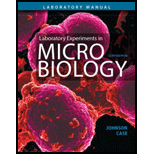
Concept explainers
To write:
The effectiveness of autoclaving, boiling, microwaving and dry heating.
Introduction:
Sterilization is the killing or removal of all the living microorganisms, including the bacterial spores that are highly resistant. It is usually carried out by autoclaving or moist heating, boiling, microwaving and dry heating as the effective methods and consists of maximum exposure to steam as well.
Explanation of Solution
Autoclaving is a moist heat sterilization method that uses high-pressure steam. This process works by the concept that the boiling point of water or steam increases when it is under pressure. The steam inside the autoclave attacks the microorganisms and kills them. Boiling is a simple method of heating water to a high temperature of 100°C, kills most of the pathogenic microorganisms.
Microwaving is a thermal process and most of the processed foods are heat treated to kill the microorganisms. It does not kill the microorganisms completely. Dry heating kills or removes all the microorganisms, including bacterial spores. It requires a longer time for exposure as well as higher temperatures as well. Its higher temperature kills the microorganisms using a destructive oxidation method. Moist heating or autoclaving is the most effective way of killing all the microorganisms, because of its ability to penetrate microbial cells. It is followed by dry heating and then, boiling is effective as it produces heat more thoroughly and flashover can be avoided as compared to microwaving.
Thus, the effectiveness of moist heating or autoclaving is the highest, followed by dry heating that requires longer time and the temperature, then boiling with temperature of 100°C and lastly, microwaving which is a thermal process.
Want to see more full solutions like this?
Chapter 22 Solutions
Laboratory Experiments in Microbiology (12th Edition) (What's New in Microbiology)
- Diff erentiate between thermal death point and thermal death time, and provide examples of their uses.arrow_forwardGive the importance of heating as a laboratory techniquearrow_forwardHow can a life cycle of microorganism and heat resistance graph be used to determine the boiling time and temperature of heat treatment?arrow_forward
- Given the following common laboratory materials, which of the three methods of heat sterilization do you think is the most appropriate and practical to use in sterilizing them ? Why do you think so ? a) empty flask b)L-rod (glass rod c)10 ml glass pipet d) wire needles e)antibiotic solutionarrow_forwardWhat is an alternative to autoclaving for sterilizing heat-sensitive materials?arrow_forwardUsing pasteurization techniques as a model, compare the TDTs and explain the relationships between temperature and length of exposure.arrow_forward
- What is the pathogen that exhibits the greatest resistance to heat treatment is the bacteria ?arrow_forwardDraw and discuss the airflow of Chemical Fumehood, Clean bench, and Class II Biological Safety Cabinet.arrow_forwardDescribe how foods are lyophilized and compare the advantages and disadvantages and effects of lyophilization on the product compared to other drying methods?arrow_forward
